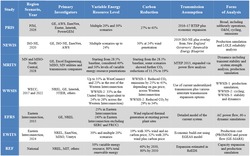News Release from American Clean Power Association (ACP)
Wind Industry Profile of
How will the US wind sector meet its role in the Clean Power Plan
Recent reports from the Advanced Energy Economy (AEE) Institute and National Renewable Energy Laboratory (NREL) bolster the case made by other experts over the last month that wind energy is key to cost-effectively and reliably meeting the Environmental Protection Agency’s Clean Power Plan.
The AEE documents how wind energy costs have declined by more than half over the last five years, thanks to technological improvements, economies of scale, and greater domestic manufacturing. However, it notes, wind cost estimates compiled by the Energy Information Administration (EIA) have failed to keep pace with the wind cost reductions observed in the market, so EIA, EPA, and other groups that rely on EIA’s numbers continue to underestimate future wind energy deployment. AWEA compiled the following table showing how EIA consistently overstates current wind energy costs. EIA’s cost data are even more inaccurate when used as estimates of future wind costs, which are widely expected to continue their downward trend. AEE’s report catalogues how EIA has consistently underestimated future renewable energy deployment as a result of these flawed assumptions.
In fact, AEE notes that EIA actually “assumes that the cost of wind energy increases over time” based on the assumption that the “most attractive sites [are] being developed first.” However, AEE points out that “turbine design enhancements, such as larger rotors and taller towers, are raising capacity factors, improving the economics of wind power production at lower-quality wind sites and opening up markets that were formerly not accessible. Thus, while the best wind sites are likely to be developed first, there is no reason to assume that wind power prices will rise over time, especially in the face of market trends showing the exact opposite.”

Because it uses a wind cost estimate that is about 20 percent too high, last month’sEIA analysis, which still shows wind energy playing a critical role in the lowest-cost compliance mix, may have actually been a conservative estimate of the role wind energy will play in Clean Power Plan compliance. EPA also underestimates future wind deployment by using EIA wind cost data, both in the Regulatory Impact Analysis that accompanied the Clean Power Plan release and in the Technical and Economic renewable energy target setting method that may be used to set the binding state targets for emissions reductions. Unfortunately, many grid operators, utilities, and state regulators also continue to use EIA’s outdated wind cost data when conducting critical generation and transmission planning, leading them to underinvest in wind energy. Utility system planners modeling options for complying with the Clean Power Plan should make sure to use current data on actual wind project costs, such as the real-world data provided by Lawrence Berkeley National Laboratory. Thus, the AEE report shows that wind energy can help cost effectively meet the Clean Power Plan.
NREL’s report shows that the Clean Power Plan can also be meet while maintaining electric reliability. It reviews recent studies by grid operators and other experts which unanimously conclude that renewable resources can reliably provide between 24 and 50 percent of our electricity. As summarized in the table below, these studies examined the full range of reliability issues and found that large amounts of renewable energy can be reliably accommodated. Several studies have closely examined the provision of essential reliability services, finding that wind plants are capable of providing these reliability services just as well as or better than conventional power plants. NREL’s primary conclusion after reviewing the grid operator renewable integration studies was that, “a 30% CO2 reduction has already been extensively studied, and the body of work taken as a whole shows that reliable and cost-effective compliance is possible.”

NREL’s report builds on reports released by the Brattle Group and other power system experts in recent weeks, explaining how large amounts of wind energy are being reliably integrated onto the power system today. Please open the header table to view how each report contributed to this goal.

Here is a running list of reports and other analysis documenting how meeting the Clean Power Plan and diversifying our energy mix with renewable energy will not harm and will actually improve electric reliability:
Clean Power Plan and reliability:
Susan Tierney, Eric Svenson, Brian Parsons, letter and report to Chairman Norman Bay, FERC Analysis Group on PJM
An updated analysis of NERC report, correcting flawed assumptions

Renewable energy and reliability:
To receive more information on this article, our Newsletter or find out more about what w3.windfair.net has to offer, please, do not hesitate to contact Trevor Sievert at ts@windfair.net.
Please don't forget to follow us on Twitter: w3.windfair.net on Twitter
w3.windfair.net is the largest international B2B internet platform in wind energy – ultimately designed for connecting wind energy enthusiasts and companies across the globe.
- Source:
- American Wind Energy Association
- Author:
- By AWEA Staff / Michael Goggin (Edited by Trevor Sievert / Windfair)
- Email:
- windmail@awea.org
- Link:
- www.awea.org/...


